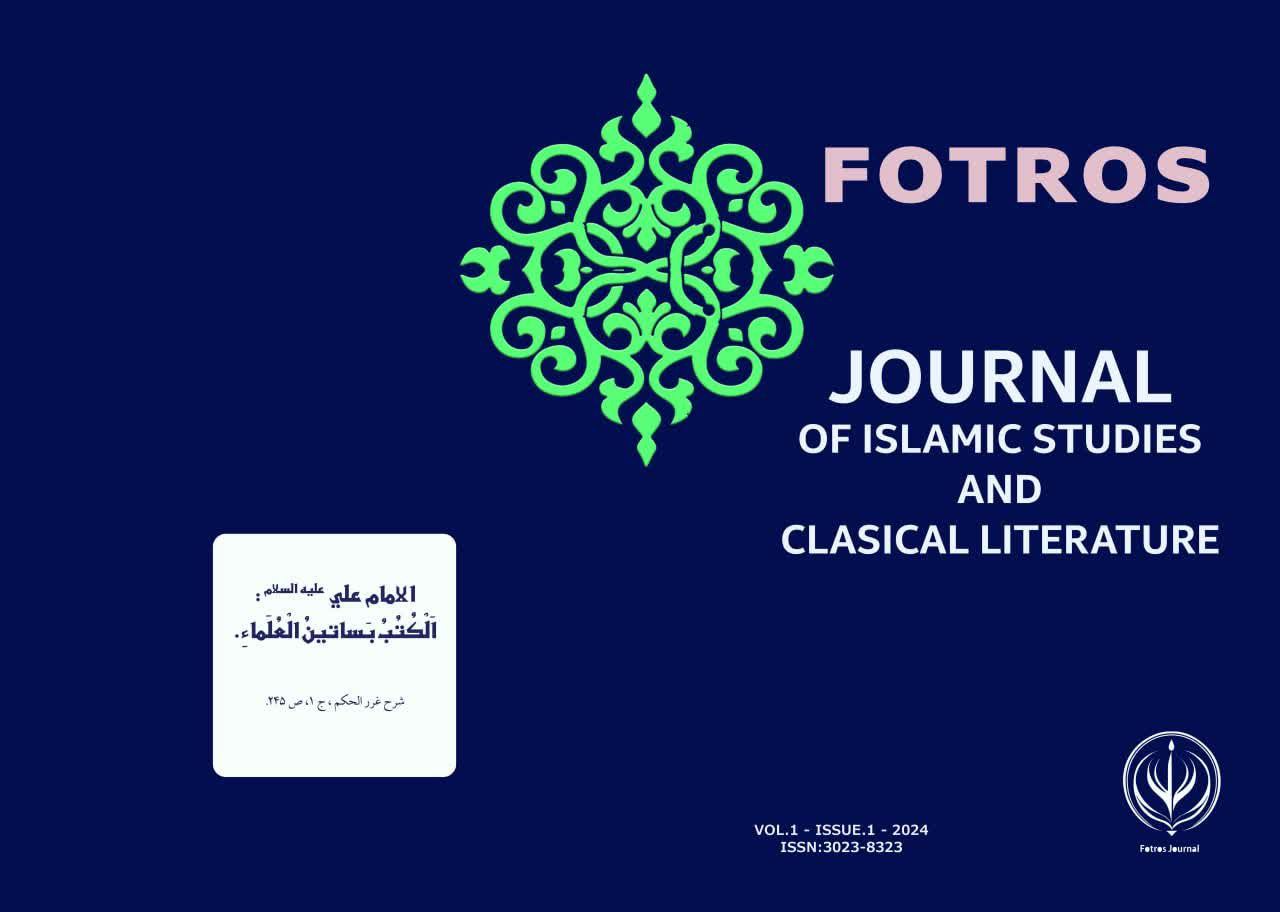Tarihsel unsurların imamet prensibini açıklamadaki rolü
DOI:
https://doi.org/10.5281/zenodo.12565184Anahtar Kelimeler:
Shi'a Teachings, Historical Context, Scripture and Tradition, Political Elements, Social Components, Cultural Framework, Economic Factors, Intellectual Currents, Imamate Presence, Quranic Foundations, Epistemological Framework, Theoretical FoundationsÖzet
Şii öğretilerinin derinlemesine sunumu ve açıklanması, yazıt ve geleneğe derinlemesine kök salmış olup, uygun bir ortamı gerektirir. Böyle bir ortamın gerçekleşmesi, etkileyici tarihsel unsurların, yani siyasi, sosyal, kültürel ve ekonomik bileşenlerin uyumu veya uyumsuzluğuyla ayrılmaz bir şekilde bağlantılıdır. Fenomenleri tarihsel bağlamında doğru bir şekilde analiz etmek için, o olayları şekillendiren tarihsel unsurları tanımak ve kullanmak zorunludur. "Tarihsel unsur" terimi, tarih boyunca belirli bir entelektüel akımı şekillendirmede rol oynamış olan daha geniş sosyal, kültürel, siyasi ve bazen de ekonomik çerçeve içindeki herhangi bir olay veya küçük bileşen anlamına gelir. Bu bileşenlerin tamamını ve uyum veya uyumsuzluk derecelerini dikkate almadan, dini içeriği anlamada görülmeyen ve ilahi alanın etkisini göz ardı ederek herhangi bir fenomenin analizi eksik kalır.
Bu unsurların dikkatli bir incelemesi, imamet dönemlerinin çeşitli dönemlerinde temel prensipleri değiştirmeksizin, Şii epistemolojik çerçevenin özet ve ayrıntılı bir şekilde sunulma sürecine olan etkilerini vurgular. Bu çalışma üç ana tartışmayı incelemeyi amaçlamaktadır: birincisi, teorik ve Kuran temelleri ve neden özet ve ayrıntılı bir açıklamanın gerekli olduğu sorusu; ikincisi, tarihsel unsurların nasıl bir rol oynadığını açıklamak; ve üçüncüsü, özet ve ayrıntılı çerçevede karşılaştırmalı örnekler sunmak. İkinci bölüm bu yönleri açıklamayı amaçlamakta olup, epistemolojik öğretilerin açıklanmasının karşılaştırmalı bir tartışmasını mümkün kılar.
Referanslar
Qaramaleki, Ahad, Methodology of Religious Studies, 8–27.
Ibn Abi al-Hadid, Abdul Hamid ibn Hibat Allah, Sharh Nahj al-Balaghah, 3/15.
Ibn al-Athir, Ali ibn Abi al-Karam, Al-Kamil fi al-Tarikh, 3/477.
Jahiz, Amr ibn Bahr, Al-Rasa'il al-Siyasiyyah, 297.
Ibid., Al-Bayan wa al-Tabyin, 1/167.
Ibn Hajar, Ahmad ibn Ali, Tahdhib al-Tahdhib, 2/211.
Kulayni, Muhammad ibn Ya'qub, Al-Kafi, 1/351.
Saduq, Muhammad ibn Ali, Uyun Akhbar al-Rida (PBUH), 2/170.
Ibn Shahr Ashub, Muhammad, Manaqib Aal Abi Talib (PBUH), 4/89.
Abu al-Faraj, Ali ibn al-Husayn, Al-Aghani, 381.
Manqari, Nasr ibn Muzahim, Waq'at Siffin, 355.
Ibn Asakir, Ali ibn al-Hasan, Tarikh Madinat Dimashq, 42/438.
Ibn al-Athir, Ali ibn Abi al-Karam, ibid., 3/477.
Ibn Kathir, Ismail, Al-Bidayah wa al-Nihayah, 8/42; Ibn Asakir, Ali ibn al-Hasan, ibid., 13/248; Waqidi, Muhammad ibn Sa'd, Al-Tabaqat al-Kubra, 10/319.
Kashshi, Muhammad ibn Umar, Rijal al-Kashshi, 266.
Kulayni, Muhammad ibn Ya'qub, ibid., 2/224.
Ibid., 3/235.
Ibid., 2/20; for examples of its social effects, see Kashshi, Muhammad ibn Umar, ibid., 163.
Najashi, Ahmad ibn Ali, Rijal al-Najashi, 10.
Kashshi, Muhammad ibn Umar, 137; Mufid, Muhammad ibn Muhammad, Al-Ikhtisas, 66.
Kashshi, Muhammad ibn Umar, ibid., 109.
Kulayni, Muhammad ibn Ya'qub, ibid., 5/362.
Ibid., 1/262.
Ibid., 3/274.
Mufid, Muhammad ibn Muhammad, ibid., 235.
Valavi, Ali Muhammad et al., Relations of Umayyad Caliphs with Dhimmi Christians and Their Role in the Progress of Muslim Sciences, Tarikh dar Ayeneh Pezhueh, Autumn 1389, Issue 27.
Ibid.
Najashi, Ahmad ibn Ali, ibid., 433.
Baghdadi, Ibn al-Nadim, Fihrist Ibn al-Nadim, 303.
For more information, see: Sami, Ali, The Efforts of Iranian Scientists and Translators in Translating Books into Arabic during the Umayyad and Abbasid Caliphates, Vahid Publication, Esfand 1348, Issue 75.
Sayyid Murtada, Ali ibn Husayn, Al-Amali, 1/94.
Mas'udi, Ali ibn Husayn, Muruj al-Dhahab, 2/224.
Najashi, Ahmad ibn Ali, ibid., 371.
Hilli, Hassan ibn Yusuf, Khulasat al-Aqwal, 15.
Najashi, Ahmad ibn Ali, ibid., 17.
Kulayni, Muhammad ibn Ya'qub, ibid., 1/515.
Kashshi, Muhammad ibn Umar, ibid., 58.
Jafariyan, Rasul, and Atlas of Shia.
Mufid, Muhammad ibn Muhammad, Al-Ikhtisas, 192; Ibid., Al-Irshad, 2/151; Dhahabi, Shams al-Din, Tarikh al-Islam, 6/438.
Ibn Shahr Ashub, Muhammad, ibid., 4/137.
Kulayni, Muhammad ibn Ya'qub, ibid., 2/20.
Kashshi, Muhammad ibn Umar, ibid., 163.
Majlisi, Muhammad Baqir, Bihar al-Anwar, 75/119; Saduq, Muhammad ibn Ali, Man La Yahduruhu al-Faqih, 1/383.
Kashshi, Muhammad ibn Umar, ibid., 164.
Arbili, Ali ibn Isa, Kashf al-Ghummah, 2/363.
Tusi, Muhammad ibn Hasan, Al-Ghaybah, 347.
İndir
Yayınlanmış
Nasıl Atıf Yapılır
Lisans

Bu çalışma Creative Commons Attribution 4.0 International License ile lisanslanmıştır.
"FOTROS Dergisi Lisans Şartları
Bir makaleyi FOTROS Dergisi'ne gönderirken, yazarlardan aşağıdaki lisans şartlarını kabul etmeleri istenir:
Creative Commons Atıf 4.0 Uluslararası (CC BY 4.0) Lisansı FOTROS Dergisi'nde yayımlanan tüm makaleler, Creative Commons Atıf 4.0 Uluslararası (CC BY 4.0) lisansı altında lisanslanmıştır. Bu lisans, diğerlerine şunları yapma izni verir:
Paylaş — Materyali herhangi bir ortamda veya formatta kopyalama ve yeniden dağıtma.
Uyarlamak — Materyali herhangi bir amaç için, hatta ticari amaçlarla bile, yeniden düzenleme, dönüştürme ve inşa etme.
Aşağıdaki şartlar altında:
Atıf — Uygun kredi vermek, lisans bağlantısı sağlamak ve değişiklik yapıldıysa bunu belirtmek zorundasınız. Bunları herhangi bir makul şekilde yapabilirsiniz, ancak lisans sahibinin sizi veya kullanımınızı onayladığını ima edecek şekilde değil.
Ek kısıtlamalar yok — Diğerlerinin lisansın izin verdiği herhangi bir şeyi yapmasını yasal olarak kısıtlayan yasal terimler veya teknolojik önlemler uygulayamazsınız.
Yazar Hakları Yazarlar aşağıdaki hakları saklar:
Telif Hakkı — Yazarlar eserlerinin telif hakkını elinde bulundurur.
Yeniden Kullanım — Yazarlar, çalışmalarını FOTROS Dergisi'nde orijinal yayına uygun şekilde teliflenmiş CC BY 4.0 lisansı veya seçtikleri herhangi bir lisans altında mevcut hale getirebilirler.
Dağıtım — Yazarlar, çalışmalarını çevrimiçi olarak (örneğin, kurumsal havuzlarda veya web sitelerinde) gönderim sürecinden önce ve sırasında dağıtabilirler, çünkü bu, ürün verimli alışverişlere ve yayınlanan çalışmaların daha erken ve daha fazla alıntılanmasına yol açabilir.
Garanti ve Tazminat Yazarlar garanti eder ki:
Çalışma orijinaldir ve kendileri tarafından yazılmıştır.
Lisansı vermek için gerekli haklara sahiptirler.
Çalışma üçüncü taraf haklarını ihlal etmez.
Yazarlar, bu garantiyi ihlalden kaynaklanan herhangi bir iddiadan FOTROS Dergisi'ni tazmin etmeyi ve zararsız tutmayı kabul eder."


